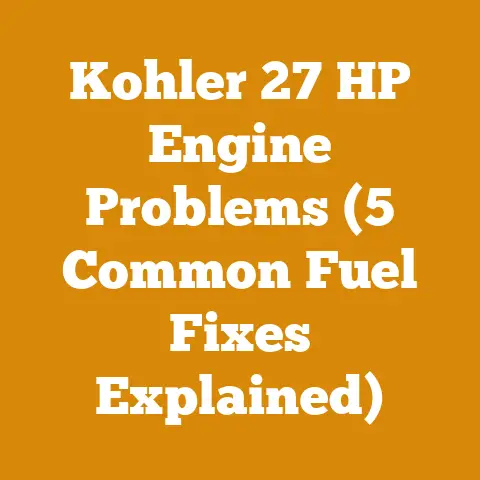Husqvarna 125B Leaf Blower Troubleshooting (Pro Arborist Tips)
Imagine this: It’s a crisp autumn afternoon. The leaves are turning, and the air is filled with that unmistakable scent of decaying foliage. You’ve just spent hours raking up a mountain of leaves, and you’re relying on your trusty Husqvarna 125B leaf blower to make short work of the cleanup. But then… nothing. It sputters, coughs, or refuses to start altogether. Frustration mounts. As a pro arborist, I’ve been there countless times. A malfunctioning leaf blower, especially during peak season, can throw a wrench in the works, costing you time, money, and maybe even a client.
This article isn’t just about fixing a leaf blower; it’s about understanding the mechanics, anticipating problems, and keeping your equipment running smoothly so you can focus on the bigger picture: efficiently and effectively managing your workload. I’m going to share my pro arborist tips and tricks for troubleshooting the Husqvarna 125B, gleaned from years of experience in the field. We’ll delve into the common issues, the less obvious culprits, and the preventative measures that can save you headaches down the road.
Understanding the Husqvarna 125B: A Foundation for Troubleshooting
Before we jump into the nitty-gritty, let’s establish a foundational understanding of the Husqvarna 125B leaf blower. This model, popular among both homeowners and professionals, is a lightweight, handheld blower powered by a two-stroke engine. Its simplicity is both a strength and a weakness. It’s easy to use, but that simplicity can sometimes mask underlying problems.
Key Components:
- Engine: A small, air-cooled two-stroke engine. This is the heart of the blower.
- Fuel System: Includes the fuel tank, fuel lines, fuel filter, carburetor, and primer bulb.
- Ignition System: Consists of the spark plug, ignition coil, and flywheel.
- Air Filter: Prevents debris from entering the engine.
- Blower Housing and Fan: Directs airflow to create the blowing force.
- Throttle Control: Regulates engine speed.
Two-Stroke Engine Basics:
Understanding how a two-stroke engine works is crucial for troubleshooting. Unlike four-stroke engines, two-stroke engines complete a power cycle in just two strokes of the piston. This means that the intake, compression, combustion, and exhaust phases all occur within a single up-and-down movement of the piston. This is achieved through ports in the cylinder walls that are opened and closed by the piston’s movement. Fuel and oil are mixed together, providing lubrication for the engine’s moving parts. This oil mixture is critical; too little oil can lead to engine seizure, while too much can cause excessive smoke and carbon buildup. The standard fuel-to-oil ratio for the Husqvarna 125B is typically 50:1 (50 parts gasoline to 1 part two-stroke oil).
Why the 125B is a Workhorse (and its Weaknesses):
The 125B’s lightweight design and ease of use make it ideal for clearing leaves, debris, and grass clippings. Its relatively low cost makes it accessible to a wide range of users. However, its small engine and reliance on a precise fuel mixture also make it susceptible to certain problems. Common issues include:
- Starting Problems: Difficult starting, no starting, or stalling.
- Poor Performance: Lack of power, surging, or misfiring.
- Excessive Smoke: Indicates an improper fuel mixture.
- Overheating: Can lead to engine damage.
Troubleshooting Step-by-Step: A Pro Arborist’s Guide
Now, let’s dive into the troubleshooting process. I’ll walk you through the most common problems and how to fix them. Remember, safety is paramount. Always disconnect the spark plug wire before performing any maintenance or repairs. Wear safety glasses and gloves. Work in a well-ventilated area.
1. No Start or Difficult Starting
This is the most frequent complaint I hear. Let’s break it down:
Step 1: Check the Fuel
- The Obvious: Is there fuel in the tank? Sounds simple, but it’s often overlooked.
- The Age of the Fuel: Fuel goes stale. After about 30 days, gasoline starts to degrade, especially when mixed with oil. The volatile components evaporate, leaving behind a gummy residue that can clog the carburetor. I’ve seen countless blowers rendered useless by old fuel. Always use fresh fuel (less than 30 days old) and mix it properly with high-quality two-stroke oil.
- Pro Tip: I always add a fuel stabilizer to my gas cans. This helps prevent fuel degradation and extends the shelf life of the fuel. Brands like Stabil and Sea Foam are excellent choices.
- The Smell Test: Does the fuel smell like gasoline? Stale fuel often has a sour or varnish-like odor. If it smells off, drain the tank and replace it with fresh fuel.
- Case Study: I once had a crew member who swore his blower wouldn’t start. After a quick sniff of the fuel, I knew the problem. He’d filled the can weeks ago and hadn’t added stabilizer. A fresh tank of gas, and the blower roared to life.
- The Fuel Filter: Located inside the fuel tank, the fuel filter prevents debris from entering the fuel line and carburetor. A clogged fuel filter restricts fuel flow, leading to starting problems.
- How to Check: Remove the fuel cap and use a clean wire or hook to pull the fuel filter out of the tank. Inspect it for dirt and debris. If it’s clogged, replace it. Fuel filters are inexpensive and readily available.
- Measurement: A clogged fuel filter can restrict fuel flow by as much as 50%, starving the engine. A new fuel filter should allow for a steady and unobstructed flow of fuel.
Step 2: Check the Spark Plug
- Location: The spark plug is located on the cylinder head.
- Removal: Use a spark plug wrench to remove the spark plug.
- Inspection:
- Wet or Dry? A wet spark plug indicates that fuel is reaching the cylinder, but the engine isn’t firing. A dry spark plug suggests a fuel delivery problem.
- Fouling: Check for carbon buildup, oil fouling, or other deposits on the electrode. These deposits can prevent the spark plug from firing properly.
- Cracks or Damage: Inspect the insulator for cracks or damage. A cracked insulator can cause the spark to leak to ground, preventing the engine from starting.
- Color: The color of the spark plug can tell you a lot about the engine’s condition. A light tan or gray color is ideal. A black, sooty spark plug indicates a rich fuel mixture (too much fuel), while a white or light gray spark plug suggests a lean fuel mixture (not enough fuel).
- Cleaning: If the spark plug is fouled, clean it with a wire brush or spark plug cleaner. You can also use a small amount of carburetor cleaner.
- Gap: The spark plug gap is the distance between the center electrode and the ground electrode. The correct gap for the Husqvarna 125B is typically around 0.025 inches (0.635 mm). Use a spark plug gap tool to adjust the gap if necessary.
- Testing: The best way to test a spark plug is with a spark plug tester. However, you can also test it by grounding the spark plug against the engine block and pulling the starter cord. You should see a strong, blue spark. If the spark is weak or non-existent, replace the spark plug.
- Pro Tip: I always carry a spare spark plug in my toolkit. It’s a cheap and easy way to eliminate a potential problem.
Step 3: Check the Ignition System
If the spark plug is good but you’re still not getting a spark, the problem may lie in the ignition system.
- Spark Plug Wire: Make sure the spark plug wire is securely connected to the spark plug.
- Ignition Coil: The ignition coil generates the high voltage needed to create a spark.
- Testing: Testing the ignition coil requires a multimeter. Disconnect the spark plug wire from the spark plug. Set the multimeter to measure resistance (ohms). Connect one probe to the spark plug wire terminal on the coil and the other probe to the engine ground. The resistance should be within the manufacturer’s specifications (typically around 2-5 ohms). If the resistance is outside of this range, the ignition coil may be faulty and need to be replaced.
- Air Gap: The air gap between the ignition coil and the flywheel is critical. If the gap is too large or too small, the ignition coil won’t function properly. The correct air gap for the Husqvarna 125B is typically around 0.010-0.014 inches (0.25-0.35 mm). Use a feeler gauge to adjust the air gap if necessary.
- Flywheel: The flywheel contains magnets that generate the electrical current for the ignition system. Make sure the flywheel is clean and free of rust or corrosion.
Step 4: Check the Carburetor
The carburetor is responsible for mixing air and fuel in the correct proportions. A clogged or malfunctioning carburetor is a common cause of starting problems.
- Primer Bulb: The primer bulb is a small rubber bulb that you press to draw fuel into the carburetor.
- Function: When you press the primer bulb, you should see fuel flowing through the clear fuel line. If you don’t see fuel flowing, the fuel line may be clogged or the primer bulb may be cracked.
- Cracks: Inspect the primer bulb for cracks or damage. A cracked primer bulb won’t create enough suction to draw fuel into the carburetor.
- Carburetor Cleaning:
- Remove the Air Filter: Remove the air filter to access the carburetor.
- Spray Carburetor Cleaner: Spray carburetor cleaner into the carburetor throat. This can help dissolve any deposits or buildup.
- Adjusting Screws: The carburetor has two adjusting screws: the high-speed screw and the low-speed screw. These screws control the fuel mixture.
- Finding the Screws: The exact location of these screws can vary depending on the model, but they are usually located on the side of the carburetor.
- Adjustment: To adjust the screws, turn them in or out in small increments (1/8 of a turn). After each adjustment, start the engine and listen to how it runs. The goal is to find the setting that allows the engine to idle smoothly and accelerate quickly. The specific settings will vary, but typically, you’ll want to turn the screws out (counter-clockwise) to richen the fuel mixture and in (clockwise) to lean the fuel mixture.
- Complete Carburetor Cleaning: A more thorough cleaning may be necessary if the carburetor is heavily clogged. This involves disassembling the carburetor and cleaning each component individually with carburetor cleaner. This is a more complex procedure that requires some mechanical skill.
- Carburetor Replacement: If the carburetor is severely damaged or corroded, it may be necessary to replace it. Carburetors are relatively inexpensive and readily available.
- Air Filter: A dirty air filter restricts airflow to the engine, leading to starting problems and poor performance.
- Inspection: Remove the air filter and inspect it for dirt and debris.
- Cleaning: Clean the air filter with soap and water. Allow it to dry completely before reinstalling it.
- Replacement: If the air filter is heavily soiled or damaged, replace it.
Step 5: Check the Compression
Low compression can also cause starting problems. Compression is the pressure created inside the cylinder when the piston moves upward. This pressure is necessary for the engine to ignite the fuel-air mixture.
- Compression Tester: The best way to check compression is with a compression tester.
- Procedure: Remove the spark plug and screw the compression tester into the spark plug hole. Pull the starter cord several times. The compression tester will measure the pressure inside the cylinder.
- Acceptable Range: The compression should be within the manufacturer’s specifications (typically around 80-120 PSI). If the compression is below this range, the engine may have worn piston rings, a damaged cylinder, or a leaky valve.
- Manual Check: If you don’t have a compression tester, you can get a rough idea of the compression by pulling the starter cord. If the engine feels easy to pull over, the compression may be low.
2. Poor Performance (Lack of Power, Surging, Misfiring)
If your Husqvarna 125B starts but runs poorly, the following steps can help:
Step 1: Revisit the Fuel System
Even if the blower starts, fuel-related issues can still cause performance problems.
- Fuel Line Cracks: Inspect the fuel lines for cracks or leaks. Cracks can allow air to enter the fuel system, causing the engine to surge or misfire. Replace any damaged fuel lines.
- Fuel Tank Vent: The fuel tank vent allows air to enter the tank as fuel is used. If the vent is clogged, it can create a vacuum in the tank, preventing fuel from flowing properly. Clean the fuel tank vent with a small wire or needle.
Step 2: Check the Exhaust System
- Spark Arrestor: The spark arrestor is a small screen located in the muffler. It prevents sparks from exiting the exhaust system and potentially starting a fire. A clogged spark arrestor restricts exhaust flow, leading to poor performance.
- Cleaning: Remove the spark arrestor and clean it with a wire brush. You can also soak it in carburetor cleaner to remove stubborn deposits.
- Muffler: A clogged muffler can also restrict exhaust flow. Check the muffler for carbon buildup or other obstructions.
Step 3: Inspect the Cylinder and Piston
This requires more advanced disassembly, but it’s crucial if you suspect internal engine damage.
- Scoring: Remove the muffler and spark plug. Use a flashlight to inspect the cylinder walls for scoring or damage. Scoring is caused by friction and can indicate a lack of lubrication or overheating.
- Piston Condition: If you see scoring on the cylinder walls, the piston may also be damaged. Remove the cylinder head to inspect the piston. Look for scoring, cracks, or other damage.
Step 4: Check for Air Leaks
Air leaks can disrupt the fuel-air mixture and cause poor performance.
- Carburetor Mounting: Make sure the carburetor is securely mounted to the engine. Loose mounting bolts can allow air to leak in.
- Intake Manifold: Inspect the intake manifold for cracks or damage.
3. Excessive Smoke
Excessive smoke from the exhaust is usually a sign of an improper fuel mixture.
- Too Much Oil: The most common cause of excessive smoke is too much oil in the fuel mixture. Make sure you’re using the correct fuel-to-oil ratio (typically 50:1).
- Old Fuel: As mentioned earlier, old fuel can cause excessive smoke.
- Choke Position: Make sure the choke is not engaged while the engine is running. The choke restricts airflow to the engine, creating a richer fuel mixture.
4. Overheating
Overheating can lead to serious engine damage.
- Airflow Obstruction: Make sure the cooling fins on the cylinder head are clean and free of debris. These fins help dissipate heat.
- Fuel Mixture: A lean fuel mixture (not enough fuel) can cause the engine to overheat.
- Engine Speed: Running the engine at excessively high speeds for extended periods can also cause overheating.
Preventative Maintenance: Keeping Your Husqvarna 125B Running Smoothly
The best way to avoid troubleshooting headaches is to perform regular preventative maintenance. Here’s a checklist I use to keep my equipment in top condition:
- Daily:
- Check the fuel level.
- Inspect the air filter.
- Clean the blower housing and fan.
- Weekly:
- Clean the air filter.
- Check the spark plug.
- Inspect the fuel lines.
- Grease any lubrication points.
- Monthly:
- Replace the fuel filter.
- Clean the spark arrestor.
- Inspect the carburetor.
- Annually:
- Replace the spark plug.
- Inspect the cylinder and piston.
- Have the carburetor professionally cleaned and adjusted.
Specific Preventative Measures:
- Fuel Stabilizer: Always use a fuel stabilizer when storing your leaf blower for extended periods.
- Fuel Storage: Store fuel in a cool, dry place. Use a sealed container to prevent evaporation.
- Air Filter Maintenance: Regularly clean or replace the air filter to ensure proper airflow.
- Spark Plug Replacement: Replace the spark plug annually to maintain optimal performance.
- Professional Servicing: Consider having your leaf blower professionally serviced annually to catch any potential problems early.
Advanced Troubleshooting: When to Call in the Pros
While I’ve covered many common troubleshooting steps, some problems require specialized knowledge and tools. Here are some situations where it’s best to call in a professional:
- Internal Engine Damage: If you suspect internal engine damage (e.g., worn piston rings, damaged cylinder), it’s best to have a qualified mechanic inspect the engine.
- Carburetor Rebuild: Rebuilding a carburetor requires specialized tools and knowledge. If you’re not comfortable with this procedure, it’s best to leave it to a professional.
- Electrical Problems: Diagnosing and repairing electrical problems can be complex. If you’re not familiar with electrical systems, it’s best to seek professional help.
The Importance of Proper Fuel and Oil
I cannot stress this enough: using the correct fuel and oil is paramount for the longevity of your Husqvarna 125B.
- Octane Rating: Use gasoline with an octane rating of 87 or higher.
- Two-Stroke Oil: Use high-quality two-stroke oil specifically designed for air-cooled engines. Husqvarna oil is a good choice, but other reputable brands are also acceptable.
- Mixing Ratio: Always mix the fuel and oil in the correct ratio (typically 50:1). Use a measuring container to ensure accuracy.
- Ethanol Content: Be aware of the ethanol content in gasoline. Ethanol can damage small engines. If possible, use ethanol-free gasoline. If you must use gasoline with ethanol, use a fuel stabilizer that is specifically designed to protect against ethanol damage.
Safety First: Protecting Yourself and Your Equipment
Operating and maintaining a leaf blower can be dangerous if proper safety precautions are not taken.
- Personal Protective Equipment (PPE): Always wear safety glasses, hearing protection, and gloves when operating or maintaining a leaf blower.
- Work Area: Work in a well-ventilated area. Avoid operating the leaf blower in enclosed spaces.
- Fuel Handling: Handle fuel with care. Avoid spilling fuel and keep it away from open flames.
- Spark Plug Wire: Always disconnect the spark plug wire before performing any maintenance or repairs.
- Manufacturer’s Instructions: Always read and follow the manufacturer’s instructions.
Strategic Insights for Arborists and Landscapers
Beyond the technical aspects, here are some strategic insights I’ve learned over the years:
- Equipment Rotation: If you have multiple leaf blowers, rotate them to distribute the workload and prevent overuse.
- Scheduled Maintenance: Implement a scheduled maintenance program to keep your equipment in top condition.
- Employee Training: Train your employees on proper operating and maintenance procedures.
- Inventory Management: Keep an adequate supply of spare parts on hand to minimize downtime.
- Record Keeping: Keep detailed records of maintenance and repairs. This can help you identify potential problems early.
Conclusion: Empowering You to Keep Blowing
Troubleshooting a Husqvarna 125B leaf blower doesn’t have to be a daunting task. By understanding the basic principles of two-stroke engines, following these step-by-step instructions, and practicing preventative maintenance, you can keep your equipment running smoothly and efficiently. Remember to always prioritize safety and to seek professional help when needed.
Now, take this knowledge and apply it. Inspect your leaf blower, check the fuel, clean the air filter. The next time your 125B sputters or refuses to start, you’ll be ready to diagnose the problem and get back to work. And that, my friends, is the true mark of a pro arborist. The ability to not only manage trees but also manage the tools that help us do our job. Good luck, and happy blowing!






